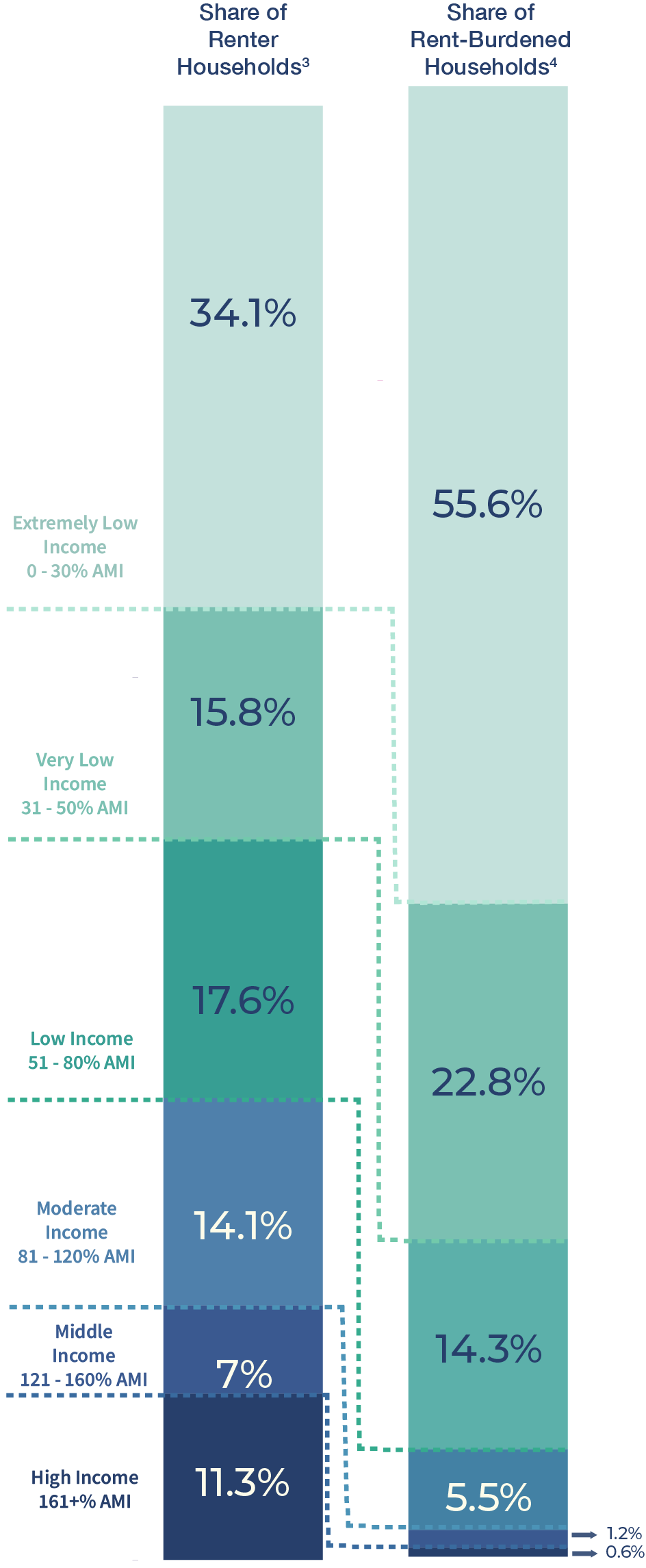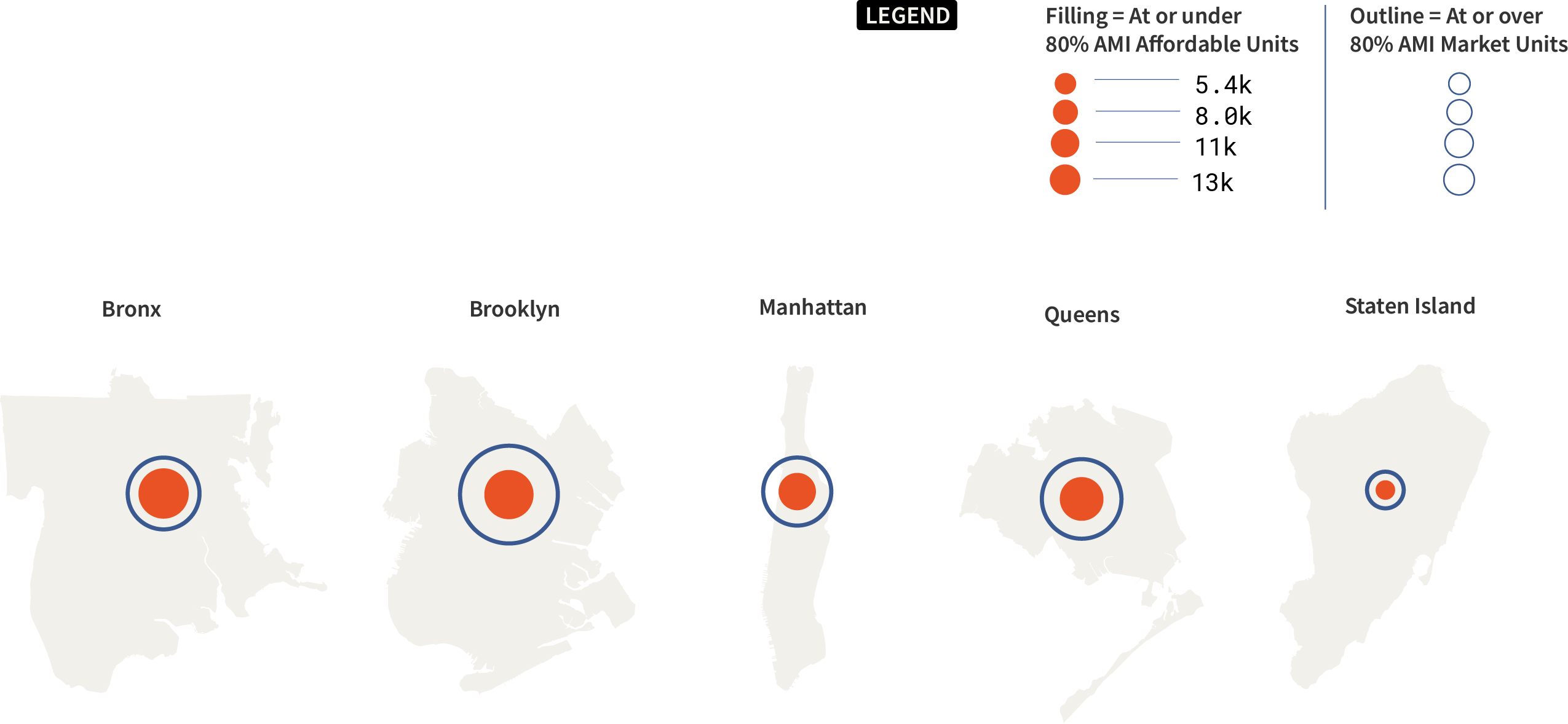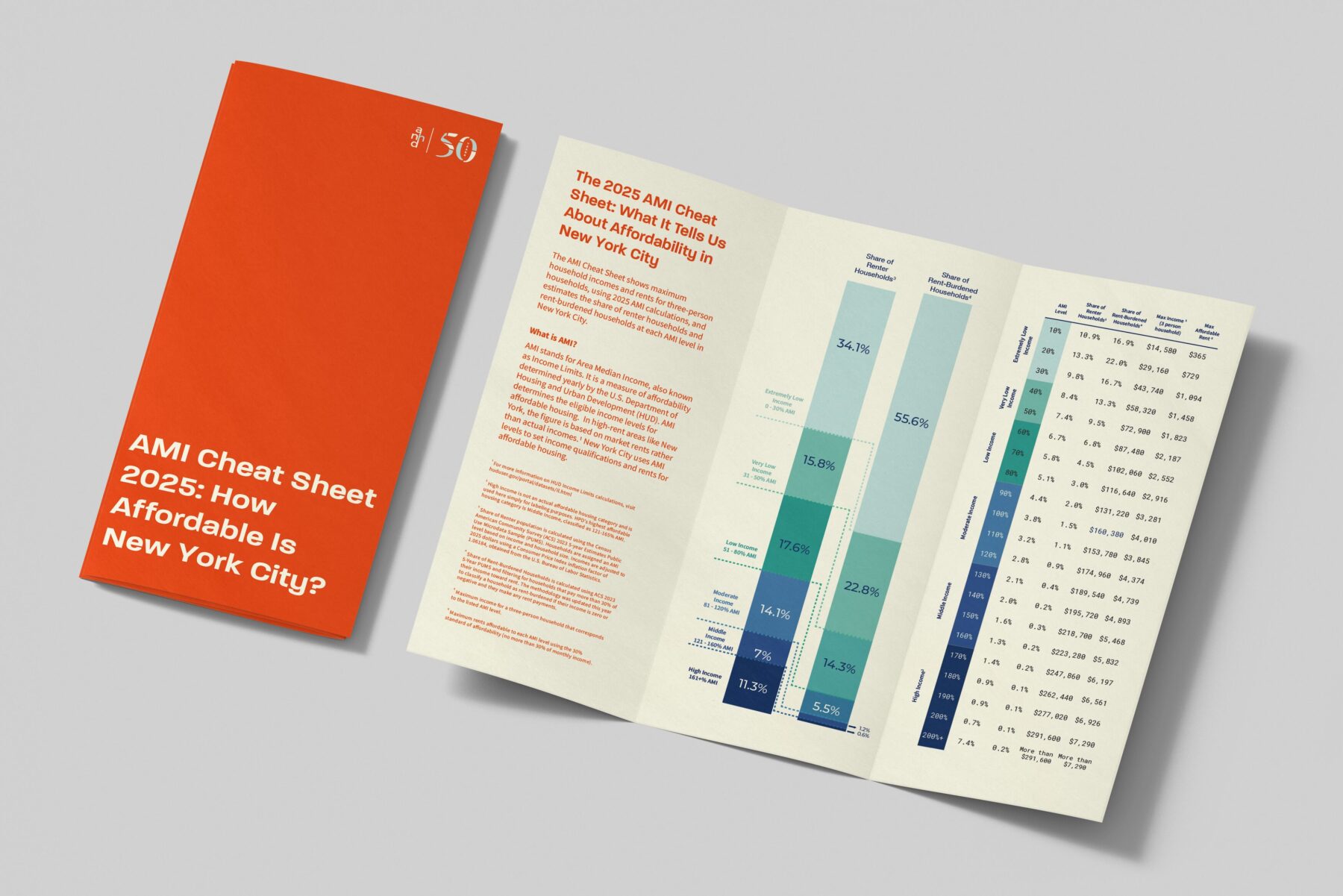ANHD’s 2025 AMI Cheat Sheet highlights the continued and urgent need for deeply affordable housing to serve the majority of NYC renters. As we approach the mayoral election this November, it’s more critical than ever that the next mayor implement a housing plan focused on deep affordability – one of the central pillars of ANHD’s Mayoral Platform. Since 2000, the city’s steady rent increases reveal how expensive New York has become and how unaffordable it is to cover living expenses. Fair market rent for a 2-bedroom apartment has nearly tripled since 2000, underscoring a relentless upward trend.1 Yet, we continue to see a consistent lack of attention paid to those households that need affordable housing the most.
ANHD’s AMI Cheat Sheet shows maximum household incomes and maximum affordable rents for three-person households, using 2025 AMI calculations, and estimates the share of renter households and rent-burdened households at each AMI level in New York City. This year’s findings reinforce the persistent trends that remain the bedrock of our current crisis, underscoring the ongoing disconnect between “affordable” housing and the needs of the communities that rely on it most.
Three issues continue to stand out:
- The majority of the affordable housing crisis is concentrated among the lowest-income New Yorkers.
- Rent burden is pervasive—and most severe—where the system provides the least support.
- Deeply affordable housing serving lower AMI households is still not being produced at the scale needed, leaving a widening gap for those most in need.
The data reinforces what housing advocates have long known: the crisis is rooted in the same enduring failures to create deeply affordable housing, and until they are directly confronted, New Yorkers most in need will continue to be left out.
The Majority of Crisis is Concentrated Among the Lowest-Income New Yorkers
As shown in the first bar graph below – 1.47 million, just over half of the city’s renters – fall below 80% AMI. This includes renters considered extremely low income, very low income, and low income. For a family of three, that means earning $72,900 a year; for a single person it would be $56,799. At these income levels, even a two-bedroom apartment at the city’s fair market rent – around $2,780 a month – would consume about 46% of annual income for a family of three, far above the federal affordability threshold of 30%.

55.6% – the largest portion – of the city’s rent-burdened households are in the Extremely Low Income category. For these households, the maximum affordable rent for a three-person household ranges from $365 to $1,094 – rents which have become very scarce in New York City.
Rent-Burden is Pervasive and Deepest Where the System Does Least
Rent burden isn’t just a statistic- it’s a daily crisis. The bar graph to the right shows that close to 80% of rent-burdened families make 50% or less AMI, leaving little room for savings, emergencies, or recovery from job loss. For larger families, where the cost of living stretches every dollar thinner, the margin for stability is even smaller, pushing more households toward eviction, doubling up with relatives, or accepting unsafe and overcrowded housing. By contrast, only 28.6% of rent-burdened households make above 80% AMI. This dramatic difference underscores how the current housing system fails those who need it most – low-income renters.
Deeply Affordable Housing is Not Being Produced at the Scale Needed
Despite the needs of lower-income, rent-burdened households, the overwhelming majority of new units built in 2024 were market-rate or priced above 80% AMI. Of those that were affordable, only 6,834 units were priced at or below 80% AMI – barely a drop in the bucket for the 989,323 rent-burdened households at those AMI levels who are struggling to get by. This tiny fraction – less than 1% of the 989,323 rent-burdened households earning at or below 80% AMI – highlights just how few units were actually created to meet their needs, leaving most New Yorkers priced out and forgotten, with a growing gap between the housing market’s promises and the realities of its failures.

The table below provides a breakdown of the 6,834 affordable units distributed across different AMI brackets.2

It is clear that deeply affordable housing– especially for those at 30% AMI– is still out of reach for the very communities that need it most. Across the city, new development favors over 80% AMI and market-rate units: Brooklyn added over 13,000, compared with just 2,153 affordable units at or below 80% AMI, while Manhattan saw 5,362 market-rate units versus 876 affordable. Even in Staten Island, only 19 new units were affordable, dwarfed by 829 market-rate units.

In the following interactive graph, you can explore a breakdown of affordable units across community districts by borough to reveal where affordable housing is and isn't being built:
- The Bronx: Areas like Hunts Point, Morrisania, and Riverdale/Fieldston are among the highest in rent burden, but these neighborhoods saw minimal below 80% AMI affordable units in 2024. Hunts Point and Morrisania had fewer than 10 new affordable units, highlighting a critical oversight in serving the city’s most vulnerable communities.
- Brooklyn: Neighborhoods like Sunset Park, Flatlands, and Brownsville, which have some of the highest rent-burden rates, experienced almost no affordable housing development. This leaves low-income families in danger of being priced out of rapidly gentrifying areas.
- Queens: Districts like Jackson Heights, Flushing, and Elmhurst, areas home to many working-class immigrants, saw virtually no affordable units built, while market-rate housing development surged in areas like Astoria and Sunnyside.
- Manhattan: Affluent areas like the Upper East Side and Financial District received no affordable housing under 80% AMI, while working-class neighborhoods like East Harlem and Washington Heights saw just a fraction of what’s needed to meet demand.
What we really need is Deeply Affordable Housing
Given the continuing disconnect between the need and the type of housing that is being built, it is imperative that the next mayor focus on creating deeply affordable housing for households earning under 30% and 50% of AMI. This is where the crisis is concentrated, and where real impact would be felt.
To build the kind of affordable housing New York City really needs, we need not only more resources, but different types of financial tools. For decades, the city’s affordable housing financing has been largely limited to capital resources. But this limitation makes it impossible to sustain rent levels low enough to serve the need. While continuing to invest capital dollars, we must bring back and expand models for providing ongoing operating subsidies – whether through project-based vouchers, a wider range of service contracts, subsidies for costs like insurance and utilities, or similar alternatives. To further support the creation of deeply affordable housing, the city must leverage public land for public good—requiring all housing built on public parcels to be 100% affordable - and prioritize community-based nonprofit housing providers in its development.
In sum, solving the city’s housing crisis will mean confronting uncomfortable truths about who new housing really serves. The next mayor must act boldly, centering those who have too long been ignored. It’s time for a housing policy that delivers not just growth, but justice.
Footnotes:
1 Two-bedroom units were chosen for this analysis as they offer a clearer picture of affordability for working families and shared households, where housing pressures are often the most visible.
2 This figure only includes units at or below 80% AMI built in 2024.
